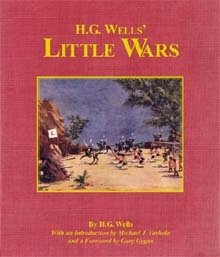Gary Gygax's Foreword to 'H.G. Wells' Little Wars'

Following is the Foreword written by Gary Gygax, creator of the Dungeons & Dragons role-playing game, for the Skirmisher Publishing LLC edition of H.G. Wells' Little Wars. Among other things, this piece reveals the influence of the famous science fiction author on the almost-equally famous game designer.
Being offered the honor of writing this introductory piece was something impossible for me to refuse. Not only am I a fan of the science fiction works of H.G. Wells, but I am also a military miniatures buff familiar with his wargaming rules, the material contained in this book, Little Wars.
Furthermore, and as icing on the cake, is that Isaac Asimov, an author I much admired, wrote the forward to the 1970 reprint of this book. Isaac and I were going to be collaborators on a series of books based on a science fiction feature film, but the movie never got into production. By writing this prefatory essay, I am following in Isaac’s footsteps, so to speak, and paying him homage in posthumous fashion.
When defending the hobby of playing military miniatures games, I have often quoted or paraphrased Wells’ statements — as I do now — regarding the fact that miniature soldiers leave no widows and orphans, and that if more people were busy fighting little wars, they might not be involved in fighting big ones.
There is no question that Wells wrote a ground-breaking work when he penned Little Wars, which started the hobby of military miniatures war-gaming. Had World War I not come hard on the heels of its first publication in 1913, military miniatures game play might have gained a far larger audience than it did back then.
As it was, the big war made interest in the book about little ones virtually disappear. For years, Little Wars was known only to a select few, mainly military miniatures gamers in the United Kingdom. Their pursuit and development of the hobby was considerable, but details of that activity remained relatively obscure elsewhere.
My own experience with creating rules for wargaming began inauspiciously. I had no idea of the existence of Little Wars or the military miniatures gaming hobby back in the early 1950s, when my friend Don Kaye and I thought we could devise rules for playing with toy soldiers — my extensive collection of World War II figurines and tank models, and the many 54 mm Britons figurines from varying periods I had collected since that war had ended.
Unlike the wise Wells — who used toothpick missiles when he fired his miniature artillery pieces — we employed ladyfinger firecrackers, fuses lit, and those explosives proved to be detrimental to the toy soldiers. Casualties were high!
Worse still, our combat system — a coin flip — turned out to be even less satisfactory. It was boring. As typical of teenage boys, we gave up on the idea rather than trying other methods of resolving small arms fire and hand-to-hand combat. The toy soldiers were stored away, and we went on to other games.
What a revelation it was when another friend loaned me his copy of Little Wars in the late 1960s. By that time, I was a board wargame devotee and I had played a few tabletop games with military miniatures. To read the rules the author had established for resolving combat made me want to slap my forehead because we had not thought of them. What a joy it was to see the pictures of grown men in suits, with collars and ties, crawling about on the floor amidst toy soldiers as my friends and I had done as boys.
No wonder, then, that the book Wells wrote managed to create a whole new hobby in the face of the Great War and its aftermath. Nothing would do but playing the original wargame as set forth in the book. This was accomplished with fellow game hobbyist — and thereafter a two-time co-author with me of military miniatures rules books — Jeff Perren. Jeff and I fought several battles, and his accuracy with toothpick artillery rounds proved devastating. Even in defeat I loved the game.
Consequently, Little Wars influenced my development of both the Chainmail miniatures rules and the Dungeons & Dragons fantasy roleplaying game. For example, it established the concept of a burst radius for cannon rounds, an idea that was translated into both the Chainmail catapult missile diameters and the areas of effect for Fireballs in D&D. Wells’ shooting/melee rules were simple but not particularly realistic, however, so wargamers soon developed more detailed means for resolving such combat, and I used the later developments in the hobby in those regards.
Beyond Little Wars, Wells’ treatment of subterranean humans in the Time Machine certainly reinforced my concepts of underground adventure areas other than dungeons (as did Jules Verne’s Journey to the Center of the Earth and a number of later works of imaginative fiction).
While military miniatures rules have come a long way since Little Wars was first published in 1913, the simple game presented in this book remains an unquestionably enjoyable one. Furthermore, when you read the work you will see that its basic concepts remain in many of today’s games. This book will give you the knowledge that there is strong fellowship between Wells and his wargaming companions and the military miniatures gamers of today. I predict that 100 years from now, readers will experience the same warm feeling across the centuries.
There is nothing more I can say — other than to enjoy your ride in this gaming time machine!
Lake Geneva, Wisconsin
March 2004



